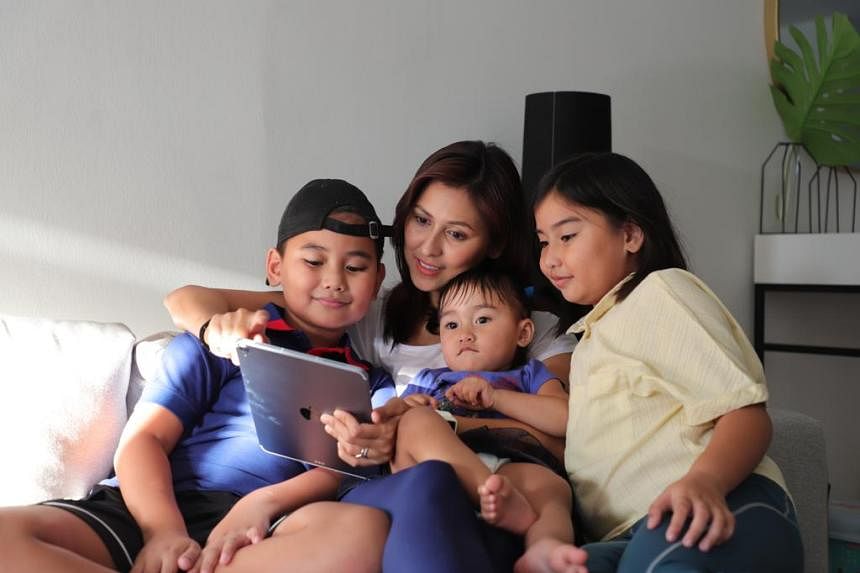The average 13-year-old doesn’t have an audience of almost 41,000 on TikTok.
But Shan Ehan is not your average 13-year-old.
As the child of content creator, TV actress and presenter Nurul Aini, he and his younger sisters are regulars in their mother’s TikTok videos. The budding stars are featured in a number of comedy videos, ranging from humorous snippets of their everyday lives, to popular dancing and singing challenges.
They do not have TikTok accounts, but rather than try to keep her children as isolated as possible from social media, Ms Nurul has instead chosen to involve them in her social media activities.
With the understanding that there is no avoiding social media in today’s digital age, she believes it is important for parents to continue guiding and supporting their children’s digital journeys.
“As a parent, I’m naturally concerned about the content out there on social media platforms and what children can get exposed to, whether it’s to do with relationships or dressing styles.
“But I think if I don’t educate my children now, they may get too easily influenced by the content on social media because it is so accessible today,” she says. “I find that cultivating healthy digital habits is important in the long run.”
Being their authentic selves online
The family's journey online and on TikTok has sparked thoughtful conversations at home – from discussions around the fundamentals of digital literacy to understanding the differences in digital appearances and reality.
“They can see from my own activities on social media platforms that people only showcase certain aspects about themselves in the online world,” continues Ms Nurul.
Plus, communal content creation and consumption has brought them closer than ever as a family. Since children below 13 are prohibited from creating accounts on social media, Ms Nurul’s daughters regularly watch makeup tutorials and K-pop dance videos together with her on her account.
“We had so much fun creating content together during the circuit breaker period,” she adds. “Plus, sometimes there will be comments on our videos that I’ll share with them, and they get so excited.”
Dealing with online criticism

But comments aren’t always positive. As someone who is regularly in the public eye, Ms Nurul has had to deal with her fair share of harsh remarks and criticism online – some of which has driven her to tears.
With the looming inevitability of her children having to deal with online criticism at some point, she finds ways to turn such issues into learning points.
For instance, while her daughter Shaista’s appearance in a recent television drama was largely positively received, Ms Nurul came across a single negative online commenter while trawling through online forums.
At first, the impulse was to hide the comment from her daughter – it was just one comment, after all.
But after consideration, she decided that it could be advantageous to use it as a learning experience for her daughter. “I realised that it would actually be better if she knew about this – that there are people out there who will leave such comments.”
Showing her daughter the comment turned into a springboard for a conversation between them about online criticism and how to deal with it. “I told her, ‘I don’t want you to get affected, because you can’t please everyone’,” she says.
“It helped to manage her expectations for the next time something like this happens – because it will.”
Ms Nurul is not alone in facing situations like these. Parents all over the world have voiced similar concerns about navigating conversations on online content – stemming from a disconnect with their teens.
Recognising this, TikTok asked thousands of teens in over a dozen countries their opinions on the type of support they really value from their parents. Their responses were compiled into five handy tips, and can be found in the Guardian’s Guide on the TikTok Safety Center.
Thankfully, says Ms Nurul, incidents like the one she and her daughter experienced are few and far between on TikTok, due to its strict stance on bullying and harassment on the platform.
TikTok also provides the community with extensive comment controls. Under the Settings and Privacy section, community members have the ability to restrict who can comment on their content, as well as bulk report or delete comments.
Measures to protect teens
TikTok keeps its Community Guidelines up to date, and is proactive in its content moderation, removing potentially harmful or offensive content such as bullying and harassment, graphic content, or hateful behaviour.
In Singapore, only those aged 13 and above can create an account for themselves. It is important that community members provide their real date of birth, as accurate information ensures users have an age-appropriate experience.
For additional safety, accounts of community members aged between 13 and 15 are set to private by default, meaning that only their friends will be able to view their content. Community members below the age of 16 cannot be directly messaged, and their content will not appear on other members’ For You pages based on the default settings.
Furthermore, only members above 16 are allowed to use TikTok’s Duet or Stitch functions, while hosting live streams – also known as TikTok LIVE – and receiving Gifts are restricted to community members who are 18 and above.
Another concern many parents share is the excessive amount of screen time children spent on social media.
“There’s so much interesting content online that you can really just keep on scrolling without realising that you’ve been online for such a long time,” Ms Nurul says. “And when you’re doing that, you’re not actively communicating and engaging with the people physically with you.”
In order to better manage screen time, Ms Nurul encourages parents to use the myriad of parental supervision tools offered by various platforms and app stores. For instance, TikTok’s Family Pairing tool allows parents and teens to customise their respective screen time settings based on their individual needs.
These measures were, of course, implemented after a candid discussion with her son about her reasons for doing so – because openness is key for any parent trying to discuss healthy online habits with their child.
Parents and their teens can also review their screen time management measures together with TikTok’s screen time dashboard. The dashboard provides an overview of screen time usage over a period of time, such as the cumulative amount of time spent on the app in the past four weeks, or how many times it was opened. This can serve as a useful yardstick with which to adjust daily or monthly screen time.
“My advice is to get your children involved in the best way possible in everything that you do, so they understand first-hand about what you’re doing, as well as your online presence and behaviour,” she says.
Whenever she is using social media and her children happen to be around, she tries to get them involved in conversations about what content she is putting up online, as well as what content they are consuming together.
“This will be helpful in ensuring that kids refrain from keeping secrets with you,” she says. “When they view content online, they will be keen to share it with you.”


